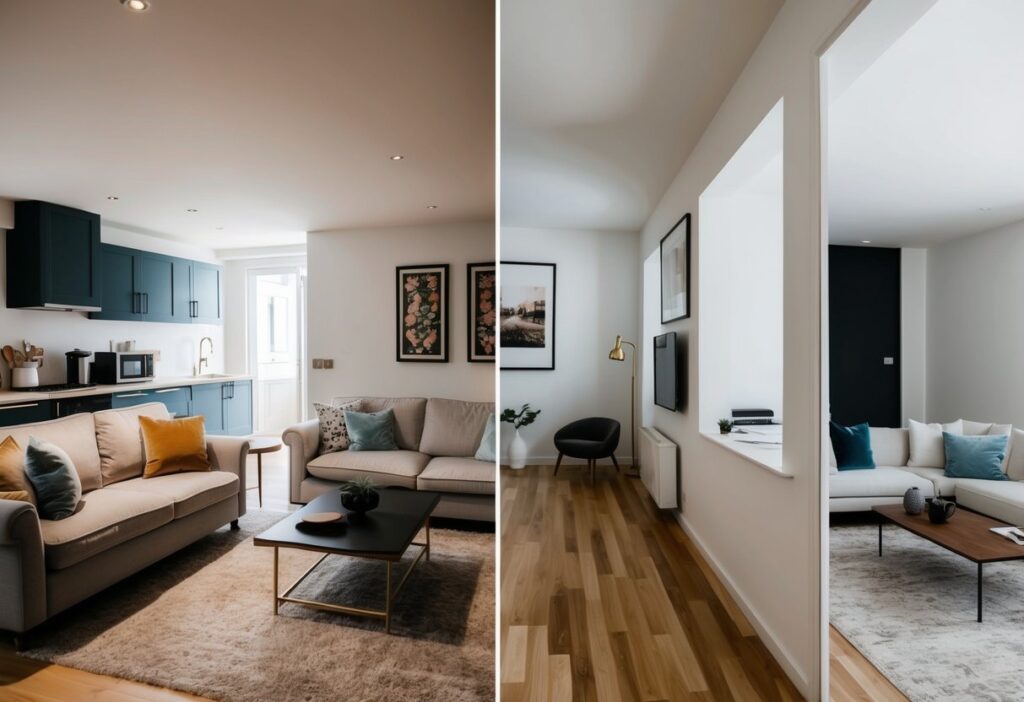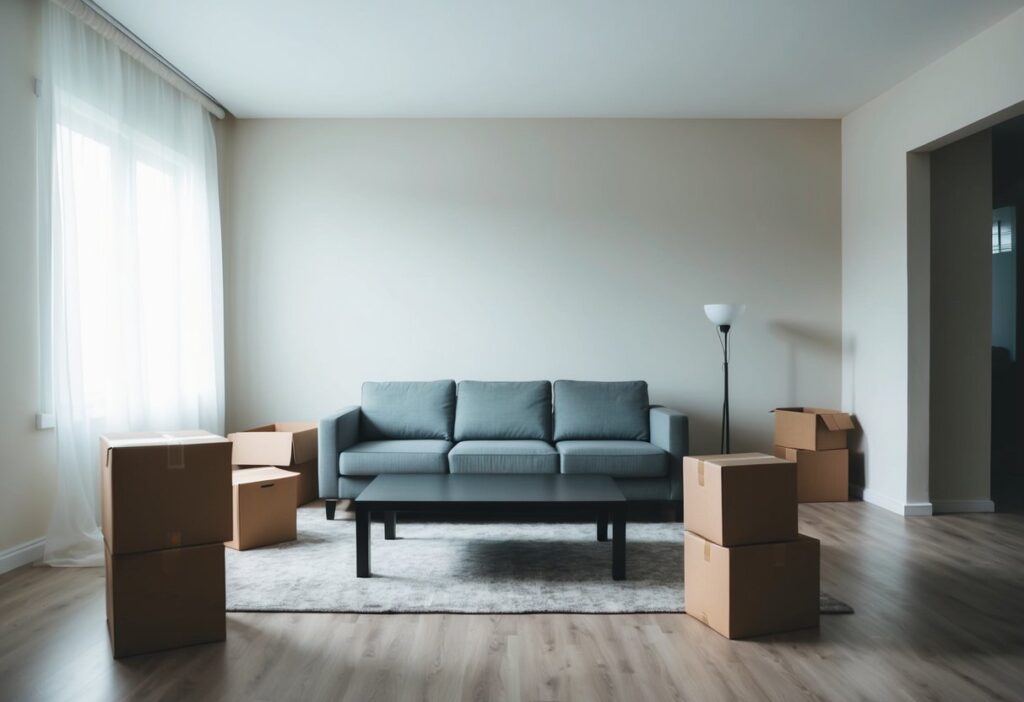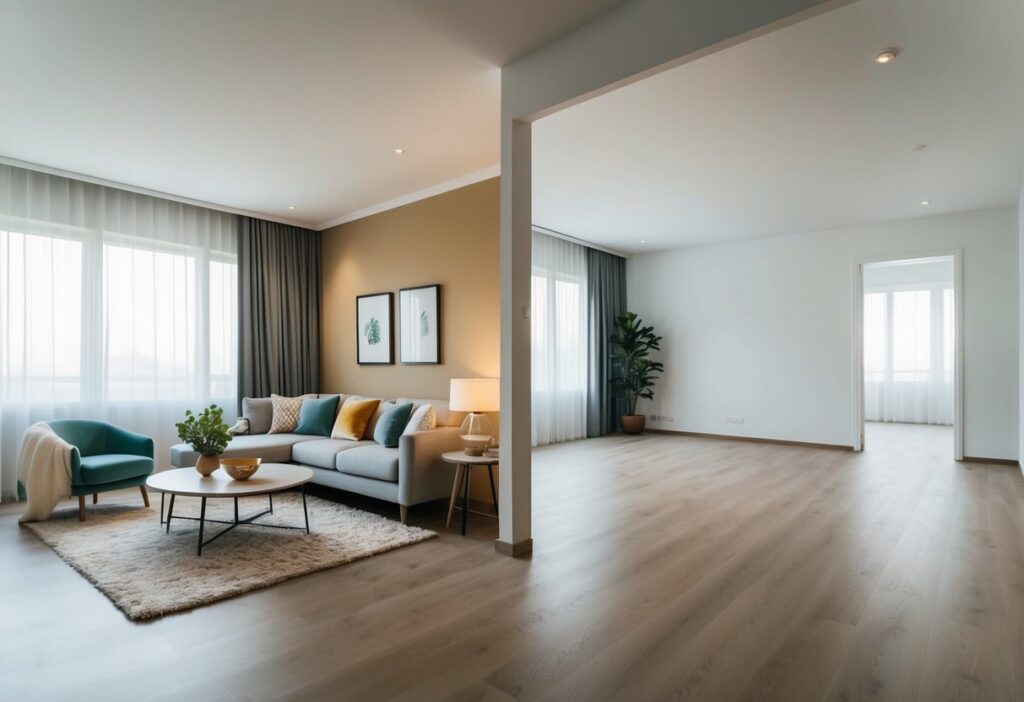Anúncios
Choosing between a furnished or unfurnished home is a major decision that affects your living experience and budget. Each option comes with distinct advantages and drawbacks that renters should carefully consider before signing a lease.

Furnished homes provide convenience and immediate move-in readiness, while unfurnished properties offer more customization options and typically lower monthly rent. The right choice depends on your lifestyle needs, budget constraints, and how long you plan to stay in the rental property.
Understanding these differences helps renters make informed decisions that align with their specific situations. Factors like relocation costs, personal style preferences, and lease flexibility all play important roles in determining which option makes more sense for your particular circumstances.
Defining Furnished and Unfurnished Rentals

Rental properties come in two main categories that affect your living experience and budget. Understanding the difference helps you make the right choice for your lifestyle needs and financial situation.
What Does ‘Furnished’ Mean?
A furnished rental comes with essential furniture and household items already in place. These typically include:
- Living room: sofa, chairs, coffee table, TV stand
- Bedroom: bed, mattress, dresser, nightstands
- Kitchen: table, chairs, basic cookware, dishes
- Bathroom: shower curtain, basic bath accessories
The level of furnishing varies widely between properties. Some offer only basic furniture, while others provide everything down to decorative items like artwork, plants, and throw pillows.
Higher-end furnished rentals might include luxury appliances, designer furniture, and smart home features. Budget options typically offer functional but basic items.
Most furnished rentals also include window treatments, lighting fixtures, and sometimes linens and towels. The specific items should be clearly listed in your rental agreement.
Understanding ‘Unfurnished’ Homes
Unfurnished rentals provide the empty space without furniture or household items. These properties typically include:
- Basic fixtures: lights, faucets, blinds/curtains
- Major appliances: refrigerator, stove, sometimes dishwasher
- Bathroom essentials: toilet, shower/tub, sink
The definition of “unfurnished” can vary by location and landlord. In some markets, unfurnished means completely empty except for bathroom fixtures. In others, basic kitchen appliances are included.
Some unfurnished rentals may fall into a “partially furnished” category. These might include built-in shelving, ceiling fans, or a washer and dryer.
Tenants are responsible for providing all furniture and household items in unfurnished rentals. This means purchasing or moving beds, couches, tables, chairs, and all personal items needed for daily living.
Pros and Cons of Renting a Furnished Home

Choosing a furnished home affects both your moving experience and ongoing living situation. The decision impacts your initial costs, monthly expenses, and flexibility in several important ways.
Pros of Furnished Rentals
Ready to move in immediately. Furnished homes allow tenants to move in with just their personal belongings. This saves significant time and effort during the relocation process.
Lower upfront costs. Without the need to purchase furniture, tenants avoid spending thousands of dollars at once. This is especially helpful for those with limited savings or who are moving temporarily.
Ideal for temporary situations. Short-term renters, such as students, traveling professionals, or those in transition between permanent homes benefit most from furnished options.
Eliminates moving heavy items. The stress and expense of transporting furniture is completely removed. This is particularly valuable for those moving long distances or to upper-floor apartments.
Opportunity to try different styles. Living with pre-selected furniture lets tenants experience design choices they might not have made themselves.
Cons of Furnished Rentals
Higher monthly rent. Landlords typically charge 15-30% more for furnished properties. This premium can add up significantly over a longer lease term.
Limited personalization options. Tenants must accept the existing furniture and decor choices. This can feel restrictive for those who want to express their personal style.
Responsibility for someone else’s items. Tenants must take care of furniture they don’t own. Damage to these items may result in deductions from security deposits.
Potentially outdated or poor-quality furniture. Not all landlords invest in high-quality pieces. Tenants might end up with uncomfortable or worn items they must live with daily.
More detailed move-in/move-out inspections. Landlords typically document the condition of each furniture piece, creating a more complicated inspection process compared to unfurnished rentals.
Pros and Cons of Renting an Unfurnished Home

Choosing an unfurnished home offers renters both freedoms and challenges that differ significantly from furnished options. The decision involves weighing financial considerations against practical needs.
Pros of Unfurnished Rentals
Lower monthly rent is often the biggest advantage of unfurnished homes. Landlords typically charge less when they don’t need to provide and maintain furniture.
Freedom to decorate allows tenants to create a space that truly feels like home. You can select furniture that matches your style and needs rather than living with someone else’s choices.
Fewer worries about damage to the landlord’s furniture means potentially more of your security deposit returned. You’re only responsible for the condition of the property itself.
Long-term savings can accumulate if you already own furniture. While the initial moving costs might be higher, your furniture becomes an investment you take with you to future homes.
Better for allergies since you bring in new, clean furniture rather than using pieces that might harbor previous tenants’ allergens or pet dander.
Cons of Unfurnished Rentals
High initial costs can be challenging as you need to purchase essential furniture immediately. These upfront expenses often include beds, couches, tables, and storage solutions.
Moving difficulties increase with unfurnished options. Moving furniture is expensive, labor-intensive, and may require special equipment or professional services.
Temporary housing situations become less practical. For short-term leases of less than a year, buying furniture might not make financial sense.
Delayed comfort is common as most people can’t furnish an entire home at once. Many tenants live with minimal furniture for months while gradually purchasing pieces as budget allows.
Disposal headaches can arise when you move out. If your next place has different space requirements, you might need to sell, donate, or store furniture that no longer fits.
Considerations for Decision Making

Choosing between furnished and unfurnished rentals requires careful thought about your specific situation and needs. The right choice depends on several key factors that vary from person to person.
Assessing Lifestyle Needs
Your daily habits and lifestyle significantly impact which option works best. Think about how often you move. People who relocate frequently may prefer furnished homes to avoid moving furniture multiple times.
Consider your work situation too. Remote workers might need specific furniture setups for home offices that rental furnishings may not provide. Students or young professionals might appreciate the convenience of furnished spaces.
Do you have strong preferences about your living environment? Some renters feel uncomfortable living with someone else’s furniture choices. Others appreciate professional interior design that comes with many furnished units.
Family situations matter as well. Those with children may need child-friendly furniture that isn’t always available in furnished rentals.
Budgeting for Furnished vs. Unfurnished
Initial Costs Comparison:
| Expense Type | Furnished | Unfurnished |
|---|---|---|
| Security deposit | Higher | Lower |
| Monthly rent | Higher | Lower |
| Furniture costs | $0 | $3,000-$10,000+ |
| Moving expenses | Lower | Higher |
Consider both short-term and long-term financial impacts. While unfurnished apartments have lower monthly costs, they require significant upfront investment in furniture.
Remember to factor in hidden costs. Furnished rentals might charge fees for damages to provided furniture. Unfurnished homes require maintenance and eventual replacement of your furniture.
Some landlords offer flexibility with partially furnished options, which can be a middle-ground solution. This might include major appliances and a few key pieces while letting you bring personal items.
Long-Term vs. Short-Term Rentals
The planned length of your stay greatly affects this decision.
For stays under one year, furnished rentals typically make more financial sense. The cost of buying furniture for brief periods rarely justifies the expense.
Short-term rentals (1-6 months) almost always come furnished, often with utilities and internet included. This offers maximum convenience for temporary relocations.
For multi-year stays, unfurnished properties usually provide better value. The initial furniture investment spreads across many months, eventually saving money compared to the premium on furnished places.
Consider future plans carefully.
If you might buy a home soon, a furnished rental prevents accumulating furniture you’ll need to move or sell later.